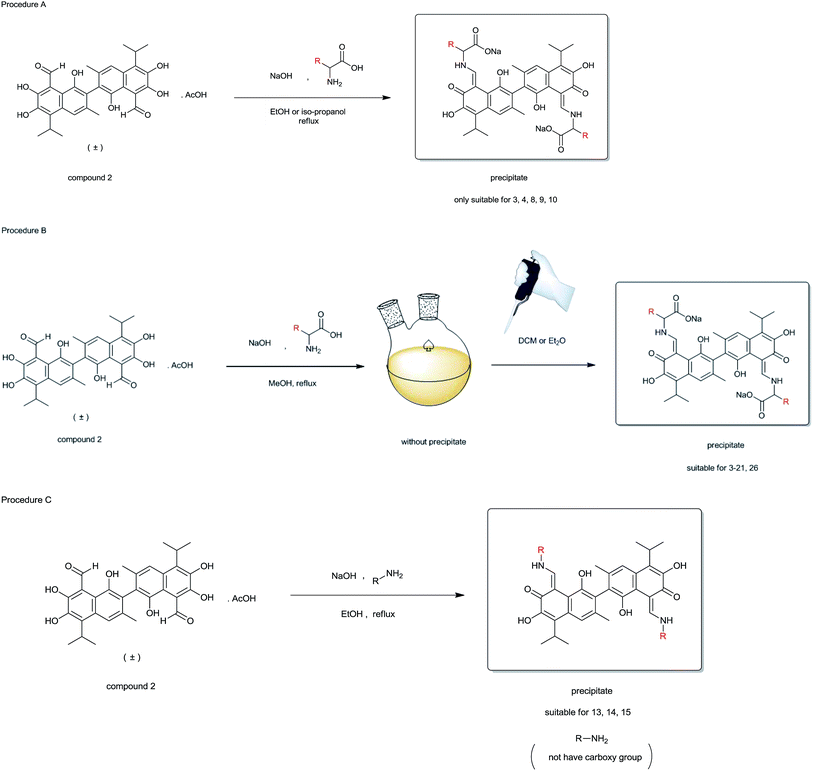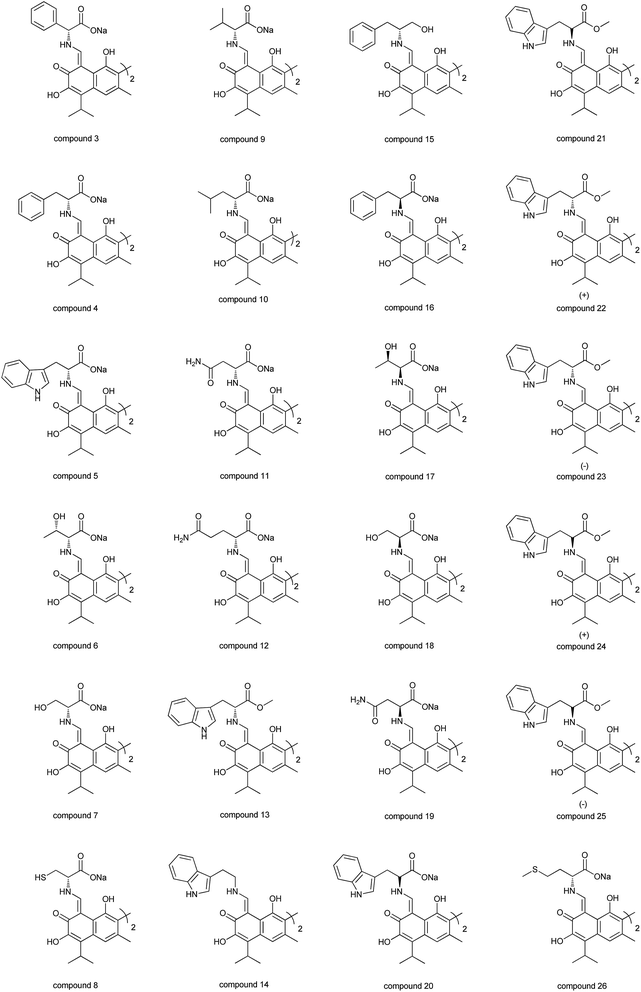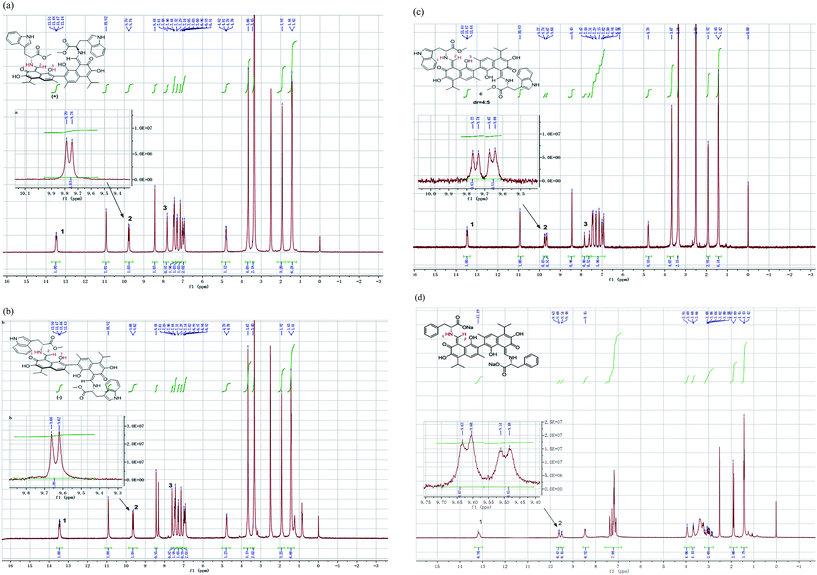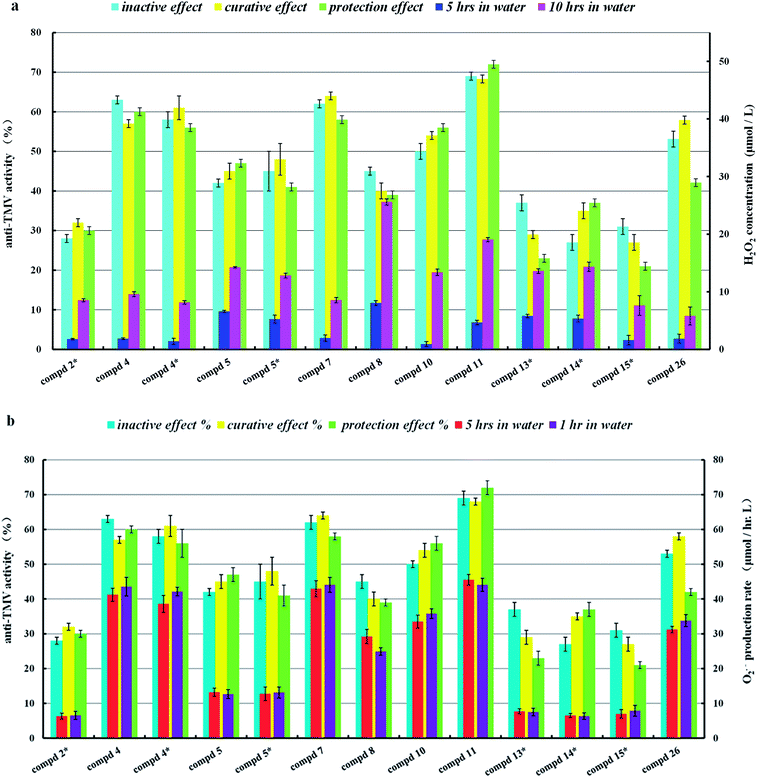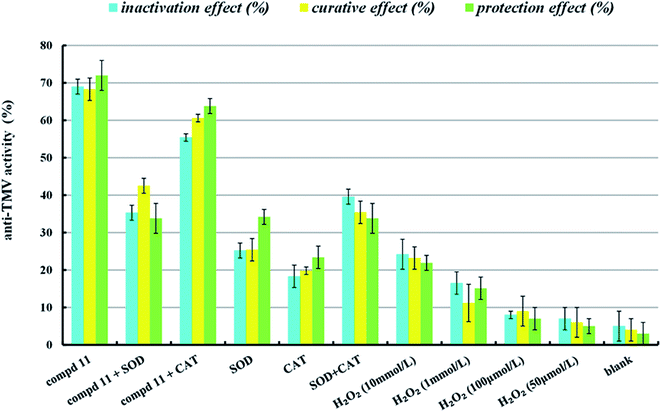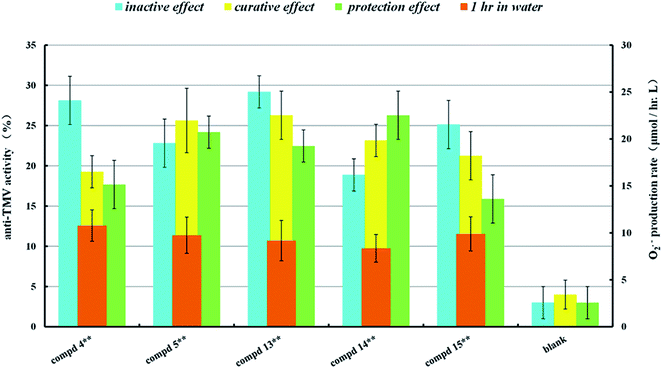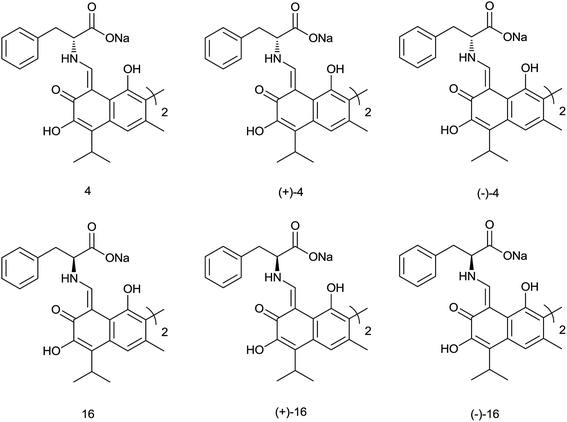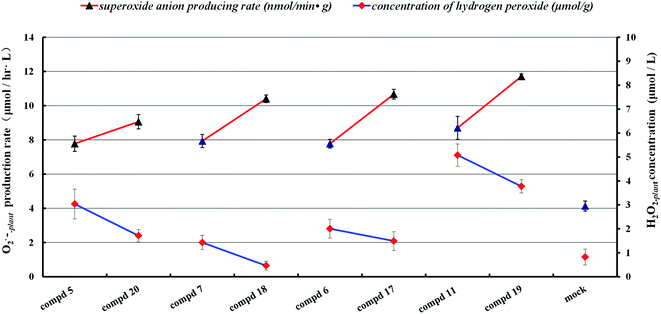Antiviral mechanism study of gossypol and its Schiff base derivatives based on reactive oxygen species (ROS)†
Bin Zhanga,
Ling Lia,
Yuxiu Liua and
Qingmin Wang*ab
aState Key Laboratory of Elemento-Organic Chemistry, Research Institute of Elemento-Organic Chemistry, Nankai University, Tianjin 300071, People's Republic of China. E-mail: wangqm@nankai.edu.cn; wang98h@263.net; Tel: +86-22-23503952
bCollaborative Innovation Center of Chemical Science and Engineering (Tianjin), Tianjin 300071, People's Republic of China
First published on 19th August 2016
Abstract
A series of amino acid gossypol Schiff bases were designed, synthesized and evaluated for their anti-TMV activities, and a new method of preparing hydrophilic amino acid gossypol Schiff bases, which are difficult to prepare using existing methods, was developed. Most of these compounds displayed good activities. Structure–activity relationship studies revealed that both the carboxy group and R group in amino acids are important to their anti-TMV activities. Further mechanism studies based on ROS-producing ability indicated that the O2˙− production rates of gossypol Schiff bases showed a positive correlation with their anti-TMV activity, suggesting that O2˙− is more important than H2O2 at the primary stage of TMV inoculation. However, the gossypol Schiff bases derived from D and L-amino acids, respectively, showed different anti-TMV activities (4 > 16, 6 > 17, 7 > 18, 11 > 19) although they had the same ROS-producing abilities. Both the D and L-amino acid gossypol Schiff bases stimulate O2˙− and H2O2 production in tobacco leaves. The current study provides fundamental support for the development of gossypol alkaloids as potential inhibitors of plant viruses.
Introduction
The use of natural products as lead compounds is one of the most effective pesticide design methods because natural products not only decompose rapidly, therefore reducing their adverse environmental impact,1–3 but also possess novel structures and mechanisms. Gossypol (1), a polyphenolic natural product (Fig. 1), displays various drug properties, including antifertility, anti-parasitic,4 anti-malarial,5 antibacterial6 and anticancer.7 Gossypol is also reported to have antiviral activity toward enveloped viruses such as HIV,8 H5N1,9 HSV-2,10 and the influenza virus,11 but not toward nonenveloped viruses. However, recently, a patent demonstrated that a (±)-gossypol fatty acid mixture shows antiviral activity against tobacco mosaic virus (TMV), which is a nonenveloped virus.12 In our previous studies, we developed a series of (±)-gossypol Schiff bases with aromatic amines13a and aliphatic amines13b which not only displayed high inhibitory activity against TMV, but also had less toxicity to rats than (±)-gossypol. Therefore, gossypol Schiff bases can serve as good lead compounds for further development of anti-TMV reagents. However, the anti-TMV mechanism of these compounds has not been studied. We also proposed that it may be the improved ROS-producing abilities of these compounds that accounts for their higher anti-TMV activities compared to gossypol. However, this idea has not yet been confirmed. | ||
| Fig. 1 Structures of (±)-gossypol 1, amino acid gossypol Schiff bases and (±)-gossypol Schiff bases. | ||
Polyphenol compounds have been demonstrated to have the ability to generate reactive oxygen species (ROS), e.g. O2˙− and H2O2.14 For example, Marklund and Xu found that pyrogallol could autoxidize rapidly under alkaline conditions, generating O2˙−.15a,b Akagawa et al. reported that both catechins and gallic acid can generate H2O2 by autoxidation under neutral-alkaline conditions.16 Doke et al. demonstrated that an O2˙− generating system was involved in the induction of necrotic lesions on tobacco leaves infected by TMV.17a However, Hafez et al. proposed that an early external application of ROS (O2˙− and H2O2) in tobacco may contribute to the development of resistance to TMV infection, while the same ROS treatments did not inhibit TMV titers if applied much later.17b,c As polyphenolic compounds, gossypol and its Schiff bases may also have ROS producing abilities,18 which may be an important factor in their anti-TMV activities. In this paper, we aim to design a series of gossypol Schiff bases with different ROS-producing abilities and determine the relationship between their structures, their ROS-producing abilities, and their anti-TMV activities.
As we can see in Fig. 1, all gossypol Schiff bases have the same skeleton (in green background); the only difference between those Schiff bases is their R groups. Therefore, we deduce that if their R groups have different antioxidative and prooxidative abilities, the Schiff bases may also have different ROS-producing abilities.
Amino acids not only have better water solubility, but also show different antioxidative and prooxidative abilities.19–21 Therefore, we suppose that introducing amino acids into gossypol Schiff bases may not only improve their water solubility but may also improve their ROS-producing abilities.
Thus, we designed and synthesized a series of amino acid gossypol Schiff bases with different amino acids and some other related amino compounds; we then systematically investigated the possible influencing factors for anti-TMV activity, such as carboxylic groups (relates to water solubility), R groups, and the D or L configuration of amino acids (Fig. 1). Furthermore, in order to verify whether the ROS-producing abilities of gossypol and its derivatives can result in anti-TMV activity at the primary stage of TMV inoculation, as well as which ROS, O2˙− or H2O2, is more important to these anti-TMV activities, we performed corresponding research and summarized these relationships.
Materials and methods
General reagents were purchased from commercial sources and were used as received. Reaction progress was monitored by thin-layer chromatography (TLC) on silica gel GF-254 with detection by UV. 1H NMR and 13C NMR spectra were recorded on a Bruker Ascend 300/400 MHz spectrometer. Chemical shift values (δ) are given in parts per million and are downfield from internal tetramethylsilane. High-resolution mass spectra (HRMS) were recorded on FT-ICR MS (Ionspec, 7.0 T). Absorbances were recorded on a BioTek Synergy 4 enzyme-labeled instrument.General procedure for the synthesis of amino acid (±)-gossypol Schiff bases
The four isomers of the gossypol Schiff bases of tryptophan methyl ester (22–25) were prepared by the method reported by Jiang's group.22
General procedure for H2O2 and O2˙− determination
In the above equation, A560 stands for the absorbance data of the mixture at 560 nm; constant A is the slope of the standard curve of H2O2; constant B is the absorbance of blank sample (c(H2O2) = 0), which is a background of this method; constant C represents the A560 of the gossypol Schiff base. The absolute values of H2O2 are expressed in micromoles per liter (μmol L−1).23
The equation of the O2˙− production rate could be described as below (see ESI†).
In this equation, A530 stands for the absorbance data of the mixture at 530 nm; constant D is the slope of the standard curve of NaNO2; constant E is the absorbance of blank sample (c(NaNO2) = 0), which is a background of this method; constant F represents the A530 of the gossypol Schiff base. The absolute values of the O2˙− production rates are expressed in nanomoles per liter per hour (nmol h−1 L−1).24
![[thin space (1/6-em)]](https://www.rsc.org/images/entities/char_2009.gif) 000 rpm for 10 min at 4 °C). The supernatant was used for protein and H2O2 concentration determination. For determination of the O2˙− production rate, we added the same volume of ethyl ether to the supernatant and separated them by centrifugation (3500 rpm for 10 min). The water phase was used for O2˙− determination. Protein content was measured using a Protein Assay Kit (Suzhou Comin Biotechnology Co. Ltd., China).
000 rpm for 10 min at 4 °C). The supernatant was used for protein and H2O2 concentration determination. For determination of the O2˙− production rate, we added the same volume of ethyl ether to the supernatant and separated them by centrifugation (3500 rpm for 10 min). The water phase was used for O2˙− determination. Protein content was measured using a Protein Assay Kit (Suzhou Comin Biotechnology Co. Ltd., China).The absolute concentration values of H2O2 are expressed in micromoles per gram protein (μmol g−1), and the O2˙− production rate values are expressed in nanomoles per gram protein per min (nmol min−1 g−1).25
Results and discussion
Chemistry
![[thin space (1/6-em)]](https://www.rsc.org/images/entities/char_2009.gif) :
:![[thin space (1/6-em)]](https://www.rsc.org/images/entities/char_2009.gif) 1. It is worth mentioning that the dr of the other gossypol Schiff bases is also about 1
1. It is worth mentioning that the dr of the other gossypol Schiff bases is also about 1![[thin space (1/6-em)]](https://www.rsc.org/images/entities/char_2009.gif) :
:![[thin space (1/6-em)]](https://www.rsc.org/images/entities/char_2009.gif) 1 as determined by 1H NMR, and the Schiff bases all exist in the enamine–enamine form in solution.
1 as determined by 1H NMR, and the Schiff bases all exist in the enamine–enamine form in solution.
Structure–activity relationship against TMV
Antiviral bioassays of the compounds against TMV were carried out, and the results are listed in Table 1. To evaluate the antiviral potency of the synthesized compounds, the commercially available plant virucide ribavirin was used as the control. As we can see from Table 1, the anti-TMV activities of these compounds in vitro were in accordance with their activities in vivo. (±)-Gossypol (1) and (±)-gossypol acetic acid (2) displayed similar in vitro anti-TMV activities (32% and 28%, respectively); however, they were less effective than ribavirin (36%) at 500 μg mL−1. In contrast, all the amino acid (±)-gossypol bases showed antiviral activities equivalent to or even higher than ribavirin both in vitro and in vivo; especially, compounds 4, 6, 7, 11 and 19 displayed obviously higher anti-TMV activities than ribavirin at a concentration of 500 μg mL−1, and their anti-TMV activities at 100 μg mL−1 even reached the level of ribavirin at 500 μg mL−1.| Compd | Concn (μg mL−1) | In vitro curative effectb (%) | In vivo activity | ||
|---|---|---|---|---|---|
| Inactivation effectb (%) | Curative effectb (%) | Protection effectb (%) | |||
| a Compounds 4, 6, 7, 11 and 19, in red, show obviously higher anti-TMV activities than ribavirin at a concentration of 500 μg mL−1.b Average of three replicates. All results are expressed as mean ± SD. | |||||
| 1 | 500 | 32 ± 1 | 35 ± 1 | 29 ± 2 | 29 ± 2 |
| 100 | 0 | 0 | 0 | 0 | |
| 2 | 500 | 28 ± 1 | 32 ± 1 | 30 ± 1 | 33 ± 2 |
| 100 | 0 | 0 | 0 | 0 | |
| 3 | 500 | 33 ± 1 | 41 ± 1 | 43 ± 2 | 36 ± 1 |
| 100 | 6 ± 2 | 15 ± 1 | 8 ± 1 | 10 ± 1 | |
| 4 | 500 | 55 ± 1 | 63 ± 1 | 57 ± 1 | 60 ± 1 |
| 100 | 21 ± 1 | 31 ± 1 | 17 ± 1 | 25 ± 1 | |
| 5 | 500 | 38 ± 1 | 42 ± 2 | 45 ± 2 | 47 ± 1 |
| 100 | 7 ± 2 | 9 ± 2 | 14 ± 2 | 11 ± 2 | |
| 6 | 500 | 58 ± 2 | 68 ± 2 | 63 ± 1 | 64 ± 2 |
| 100 | 27 ± 1 | 30 ± 1 | 20 ± 2 | 34 ± 1 | |
| 7 | 500 | 53 ± 2 | 62 ± 1 | 64 ± 1 | 58 ± 2 |
| 100 | 15 ± 1 | 19 ± 2 | 22 ± 1 | 32 ± 1 | |
| 8 | 500 | 35 ± 1 | 45 ± 1 | 40 ± 1 | 39 ± 1 |
| 100 | 0 | 20 ± 2 | 12 ± 3 | 16 ± 1 | |
| 9 | 500 | 50 ± 2 | 50 ± 1 | 46 ± 2 | 41 ± 1 |
| 100 | 22 ± 1 | 16 ± 1 | 10 ± 1 | 7 ± 1 | |
| 10 | 500 | 43 ± 2 | 50 ± 1 | 54 ± 2 | 56 ± 2 |
| 100 | 27 ± 2 | 11 ± 1 | 20 ± 1 | 17 ± 1 | |
| 11 | 500 | 67 ± 2 | 69 ± 2 | 58 ± 1 | 72 ± 1 |
| 100 | 38 ± 2 | 24 ± 2 | 36 ± 1 | 33 ± 1 | |
| 12 | 500 | 41 ± 2 | 48 ± 1 | 46 ± 1 | 51 ± 2 |
| 100 | 16 ± 2 | 22 ± 1 | 13 ± 1 | 18 ± 1 | |
| 13 | 500 | 46 ± 2 | 37 ± 2 | 29 ± 1 | 23 ± 2 |
| 100 | 0 | 0 | 0 | 0 | |
| 14 | 500 | 22 ± 2 | 27 ± 1 | 35 ± 2 | 37 ± 2 |
| 100 | 0 | 6 ± 4 | 0 | 0 | |
| 15 | 500 | 20 ± 1 | 31 ± 2 | 27 ± 2 | 21 ± 1 |
| 100 | 0 | 0 | 0 | 0 | |
| 16 | 500 | 49 ± 2 | 49 ± 1 | 51 ± 1 | 41 ± 1 |
| 100 | 18 ± 2 | 25 ± 1 | 19 ± 1 | 13 ± 1 | |
| 17 | 500 | 60 ± 1 | 57 ± 1 | 50 ± 2 | 55 ± 1 |
| 100 | 14 ± 2 | 24 ± 1 | 21 ± 2 | 29 ± 2 | |
| 18 | 500 | 39 ± 1 | 47 ± 1 | 43 ± 1 | 54 ± 1 |
| 100 | 9 ± 1 | 17 ± 1 | 11 ± 1 | 15 ± 1 | |
| 19 | 500 | 56 ± 1 | 65 ± 1 | 68 ± 1 | 59 ± 1 |
| 100 | 28 ± 2 | 33 ± 1 | 27 ± 1 | 36 ± 1 | |
| 20 | 500 | 57 ± 1 | 52 ± 2 | 50 ± 1 | 59 ± 1 |
| 100 | 24 ± 2 | 17 ± 2 | 27 ± 1 | 29 ± 1 | |
| 21 | 500 | 39 ± 1 | 36 ± 1 | 34 ± 1 | 46 ± 1 |
| 100 | 8 ± 1 | 0 | 11 ± 1 | 6 ± 2 | |
| 22 | 500 | 22 ± 1 | 32 ± 1 | 27 ± 1 | 24 ± 1 |
| 100 | 0 | 0 | 0 | 0 | |
| 23 | 500 | 44 ± 1 | 48 ± 1 | 51 ± 1 | 57 ± 1 |
| 100 | 9 ± 2 | 27 ± 1 | 12 ± 1 | 18 ± 1 | |
| 24 | 500 | 32 ± 1 | 47 ± 1 | 39 ± 1 | 36 ± 1 |
| 100 | 9 ± 2 | 23 ± 1 | 16 ± 1 | 6 ± 1 | |
| 25 | 500 | 31 ± 2 | 37 ± 1 | 29 ± 1 | 43 ± 1 |
| 100 | 6 ± 2 | 11 ± 1 | 15 ± 1 | 18 ± 1 | |
| 26 | 500 | 51 ± 1 | 53 ± 1 | 58 ± 2 | 42 ± 2 |
| 100 | 16 ± 2 | 24 ± 1 | 20 ± 1 | 16 ± 2 | |
| Ribavirin | 500 | 36 ± 1 | 39 ± 2 | 33 ± 1 | 40 ± 1 |
| 100 | 0 | 19 ± 1 | 8 ± 1 | 13 ± 1 | |
Therefore, we proposed that the anti-TMV activities of these compounds were somehow consistent with their water solubilities (4 > 15, 5 > 13, 14) and that the carboxyl groups (in sodium carboxylate form) of the amino acid gossypol Schiff bases were beneficial to both their solubilities and anti-TMV activities, whereas methyl ester and hydroxymethyl groups were unfavorable (H, CH2OH, CO2Me < CO2Na).
As shown in Table 1, D-valine gossypol Schiff base 9 exerted moderate anti-TMV activity at 500 μg mL−1. Although D-leucine is just one carbon atom longer than D-valine, the D-leucine gossypol Schiff base 10 showed slightly higher activity than D-valine gossypol Schiff base 9. However, when comparing 11 with 12, 11 showed higher activity. This suggests that the carbon chain length of the amino acid also affects the activity, and the lengths of leucine 10 and asparagine 11 are favorable.
Furthermore, D-threonine gossypol Schiff base 6 showed better activity than 9, which indicates that the anti-TMV activity can be improved by substituting the methyl group of D-valine with a hydroxyl group.
Serine can be regarded as replacing the methyl group in threonine by an H atom. The serine gossypol Schiff base 7 also displayed a high inhibitory effect. However, cysteine gossypol Schiff base 8, which could be regarded as a derivative of 7, exhibited a lower inhibitory effect than 7; the possible reason for its low activity may be the relatively poorer water solubility of 8 compared to 7.
Comparing the R groups in the amino acid Schiff bases, substituents which show hydrophilic properties are beneficial to the anti-TMV activities of the corresponding compounds, whereas hydrophobic substituents are unfavorable (10 < 11; 9 < 6; 8 < 7).
Relationship between anti-TMV activity and ROS-producing activity
Hafez has reported that externally applied ROS-producing compounds that infiltrate into tobacco leaves at the primary stage of inoculation can suppress the replication of TMV.17b,c On that basis, we supposed that the anti-TMV activities of gossypol and its Schiff bases may be related to their ROS-producing activities. To date, there is little scientific evidence available regarding the H2O2 or O2˙− producing ability of gossypol; there is also little evidence regarding which ROS, H2O2 or O2˙−, is more important to its anti-TMV activities. Therefore, a series of D-amino acid gossypol Schiff bases with different oxidative and antoxidative abilities were synthesized, and their ROS-producing abilities were tested.As shown in Fig. 4a, most gossypol Schiff bases showed obviously higher H2O2 concentrations than gossypol, except for compounds 13, 14 and 15. However, there is no obvious correlation between their anti-TMV activities and their H2O2 concentrations. We also noticed that the concentration of H2O2 is very low in fresh solutions of the gossypol Schiff bases. As the time increased from 5 h to 10 h, the concentration of H2O2 increased slowly. Hafez et al. demonstrated that applying ROS at the early stage of TMV infection is necessary to their anti-TMV activities; therefore, we suppose the H2O2 concentration may not be high enough in the primary stage of infection.17b,c To confirm this view, the anti-TMV activities of H2O2 at different concentrations were measured. It can be seen from Fig. 5 that H2O2 at 10 mmol L−1 exerts moderate anti-TMV activity; however, no activity was observed at a concentration of 100 μmol L−1, which explains why the H2O2 producing abilities of those gossypol Schiff bases do not positively correlate with their anti-TMV activities.
By contrast, the O2˙− production rate can reach a fixed level within an hour. All the amino acid gossypol Schiff bases showed higher O2˙− production rates than gossypol (Fig. 4b). Additionally, there is a significantly positive correlation between their O2˙− production rates and anti-TMV activities (in vivo).
To further verify the importance of H2O2 and O2˙−, the most potent compound, 11, was mixed with superoxide dismutase (SOD) or catalase (CAT) when spraying it on the tobacco leaves (Fig. 5). The results of this study demonstrated that application of SOD significantly reduced the anti-TMV activities of 11, which suggests that O2˙− is involved in the TMV-inhibiting activity. By contrast, the addition of CAT did not reduce the anti-TMV activity as much as SOD, which implies that H2O2 may also be involved in the anti-TMV mechanism but may not be as important as O2˙−. However, SOD and CAT did not totally suppress the anti-TMV activity of 11. The reason for this is that SOD and CAT themselves display anti-TMV activities (Fig. 5).17a,c
As mentioned above, water solubility and O2˙− production rate both appear to be related to the anti-TMV activities of these compounds. We wished to determine which is more important: water solubility, ROS producing ability, or both.
For this purpose, the relationship between the water solubility and anti-TMV activities of different gossypol amino acid Schiff bases were explored; the results revealed that the water solubilities of the compounds are not positively correlated with their anti-TMV activities (Fig. 3, ESI†).
The O2˙− producing abilities of polyphenol compounds are higher under alkaline conditions than in neutral conditions. On the basis of this, we propose that the carboxyl group in compounds 4 and 5, which are in form of sodium salts, offered relatively more alkaline conditions than gossypol Schiff bases 13, 14, and 15, and that these alkaline conditions facilitate the production of O2˙− (Fig. 4b). In order to verify this, acidic conditions were used to convert some percentage of the carboxyl groups from the sodium salts to carboxylic acid groups. The study revealed that when compounds 4, 5, 13, 14 and 15 were dissolved in solvent comprising 10% DMF and 90% NaAc–HAc buffer solution (pH = 4), the anti-TMV activities and O2˙− production rates of these compounds all decreased (Fig. 6). The differences between compounds 4 and 15 and between compound 5 and compounds 13 and 14 in this solvent are smaller than those in solvent containing 10% DMF and 90% water (Fig. 4b).
Relationship between anti-TMV activity and chirality
Each pair of (±)-gossypol Schiff bases with chiral amino acids, such as 4 and 16, 6 and 17, 7 and 18, and 11 and 19, differs only in the optical configurations of the amino acid. As we can see in Fig. 7, compounds (+)-4 and (−)-16 and compounds (−)-4 and (+)-16 are enantiomers, separately; therefore, they theoretically have the same ROS-producing abilities. Accordingly, compounds 4 and 16, which are composed of (+)-4 and (−)-4 and (+)-16 and (−)-16, respectively, have the same ROS-producing abilities. Therefore, if their anti-TMV activities are only related to their ROS-producing abilities, their anti-TMV activities should also be the same. However, as is shown in Table 1, the (±)-gossypol Schiff bases of D-phenylalanine, D-threonine, D-serine and D-asparagine all displayed higher anti-TMV activities than the L-amino acid Schiff bases (4, 6, 7, 11 > 16, 17, 18, 19). This reminds us that, in addition to the ROS-producing abilities of these compounds, chirality may be another factor influencing their anti-TMV activities. One reason for this effect may be the different responses of tobacco to D and L amino acid derivatives, which may influence the multiplication of TMV. Another reason may be the slower rate of degradation of the D amino acids compared to their corresponding L-isomers.29 We found that the four isomers of the methyl tryptophan gossypol Schiff bases (22, 23, 24, and 25) displayed different anti-TMV activities; compound 23, which is prepared from methyl D-tryptophan and (−)-gossypol, exerted the highest anti-TMV activity, even higher than that of the D-tryptophan gossypol Schiff base (5). Therefore, the (+) and (−)-configurations of gossypol should also be considered as one of the variables that could affect the anti-TMV activities of these compounds.| ROS-plant = ROS-exo + ROS-endo | (1) |
| ROS-endo = ROS-before + ROS-after | (2) |
| ROS-plant = ROS-exo + ROS-before + ROS-after | (3) |
As we can see in eqn (1), ROS-plant is the only ROS data we can obtain experimentally. This value comprises ROS-exo (the ROS produced by the gossypol Schiff base itself) and ROS-endo (the ROS related to tobacco). ROS-endo is composed of ROS-before (the ROS in tobacco before spraying the compound on the leaf) and ROS-after (the ROS produced by the interaction between the compound and tobacco).
To make ROS-plant a useful index, we must simplify eqn (3) in a reasonable way. As is known, the ROS-before values are different in different leaves. To simplify eqn (3), we used the same leaf to perform all the experiments; thus, the ROS-before values of the different gossypol Schiff bases are the same, and eqn (3) can be transferred into eqn (4). We also notice that, in this case, the value of ROS-before is equal to that of ROS-plant of the mock (ROS-mock) sample.
| ROS-plant = G + ROS-exo + ROS-after (G = ROS-before = ROS-mock) | (4) |
As we can see in eqn (4), the differences between the ROS-plant values of the gossypol Schiff bases and the ROS-mock value of the sample are equal to the sum of ROS-exo and ROS-after, and they reflect the changes of the ROS in tobacco after the compounds have been sprayed on the tobacco leaf.
When the amino acid gossypol Schiff bases have the same ROS-producing abilities, ROS-exo can be regarded as another constant H; therefore, eqn (4) can be converted into eqn (5).
| ROS-plant = G + H + ROS-after (G = ROS-before, H = ROS-exo) | (5) |
According to eqn (5), for example, the difference between the ROS-plant values of compounds 11 and 18 is equal to that of ROS-after; therefore, this difference can reflect the different responses of tobacco to the D and L amino acid gossypol Schiff bases.
As we can see in Fig. 8, all the H2O2 concentrations and O2˙− production rates are higher than that of the mock sample, except for the H2O2-plant of 18. This implies that the application of amino acid gossypol Schiff bases could stimulate the production of ROS in tobacco leaves. The asparagine gossypol Schiff bases (compounds 11 and 19) exerted the highest ROS levels among the amino acid Schiff bases. It also can be seen that the H2O2-plant and the O2˙−-plant data have opposite trends: the gossypol Schiff bases derived from D-amino acids exerted higher H2O2 concentrations than those derived from L-amino acids. In contrast, the O2˙− production rates of the D-amino acid gossypol Schiff bases were lower than those of the L-amino acid gossypol Schiff bases.
From these experiments, we propose that the gossypol Schiff base first increases the O2˙− production rate in tobacco; then, the SOD inside the tobacco leaves converts O2˙− into H2O2.
| Mn+–SOD + O2˙− + 2H+ → M(n+1)–SOD + H2O2 |
The SOD in the tobacco leaf treated with D-amino acid gossypol Schiff base seems more active than that in the leaf treated with L-amino acid gossypol Schiff base.
Conclusions
Carboxyl groups, which are related to water solubility, not only improve the anti-TMV activities of amino acid gossypol Schiff bases but also enhance their ROS-producing activities. Furthermore, the properties of R groups (length and hydrophilic) in amino acids also seem to be important factors for the anti-TMV activities of these compounds. Comparing their ROS-producing abilities with their anti-TMV activities, we found that the O2˙− producing abilities of these compounds are more correlative with their anti-TMV activities than their H2O2-producing abilities. These findings suggest that O2˙− is effective at the beginning of the TMV replication process, which results in its positive correlation with anti-TMV activity. Chirality should also be a factor affecting the anti-TMV activities of these compounds. We further used ROS as an index to explore the interactions between gossypol Schiff bases and tobacco leaf. The results also demonstrate that optically pure gossypol Schiff bases can be considered for further development as a new class of plant protection agents.Acknowledgements
We are grateful to the National Natural Science Foundation of China (21132003, 21421062, 21372131, 21672117), the Specialized Research Fund for the Doctoral Program of Higher Education (20130031110017) and the Tianjin Natural Science Foundation (16JCZDJC32400) for generous financial support for our programs.Notes and references
- X. H. Qian, P. W. Lee and S. Cao, J. Agric. Food Chem., 2010, 58, 2613–2623 CrossRef CAS PubMed
.
- J. N. Seiber, J. Agric. Food Chem., 2011, 59, 1–21 CrossRef CAS PubMed
.
- Y. M. Li, L. H. Wang, S. L. Li, X. Y. Chen, Y. M. Shen, Z. K. Zhang, H. P. He, W. B. Xu, Y. L. Shu, G. D. Liang, R. X. Fang and X. J. Hao, Proc. Natl. Acad. Sci. U. S. A., 2007, 104, 8083–8088 CrossRef CAS PubMed
.
- D. J. Newman and G. M. Cragg, J. Nat. Prod., 2012, 75, 311–335 CrossRef CAS PubMed
.
-
(a) D. L. Vander Jagt, L. M. Deck and R. E. Royer, Curr. Med. Chem., 2000, 7, 479–498 CrossRef CAS PubMed
; (b) R. E. Royer, L. M. Deck, N. M. Campos, L. A. Hunsaker and D. L. Vander Jagt, J. Med. Chem., 1986, 29, 1799–1801 CrossRef CAS PubMed
.
- T. S. Lin, R. Schinazi, B. P. Griffith, E. M. August, B. F. Eriksson, D. K. Zheng, L. A. Huang and W. H. Prusoff, Antimicrob. Agents Chemother., 1989, 33, 2149–2151 CrossRef CAS PubMed
.
-
(a) P. Yildirim-Aksoy, C. Lim, M. K. Dowd, P. J. Wan, P. H. Klesius and C. Shoemaker, J. Appl. Microbiol., 2004, 97, 87–92 CrossRef PubMed
; (b) S. D. Jolad, R. M. Wiedhopf and J. R. Cole, J. Pharm. Sci., 1975, 64, 1889–1890 CrossRef CAS PubMed
; (c) M. D. Shelley, L. Hartley, P. W. Groundwater and R. G. Fish, Anticancer Drugs, 2000, 11, 209–216 CrossRef CAS PubMed
; (d) F. Yan, X. X. Cao, H. X. Jiang, X. L. Zhao, J. Y. Wang, Y. H. Lin, Q. L. Liu, C. Zhang, B. Jiang and F. A. Guo, J. Med. Chem., 2010, 53, 5502–5510 CrossRef CAS PubMed
.
-
(a) L. M. Deck, R. E. Royer, B. B. Chamblee, V. M. Hernandez, R. R. Malone, J. E. Torres, L. A. Hunsaker, R. C. Piper, M. T. Makler and D. L. Vander Jagt, J. Med. Chem., 1998, 41, 3879–3887 CrossRef CAS PubMed
; (b) B. Polsky, S. J. Segal, P. A. Baron, J. W. M. Gold, H. Ueno and D. Armstrong, Contraception, 1989, 39, 579–587 CrossRef CAS PubMed
.
-
(a) J. Yang, G. Chen, L. L. Li, W. Pan, F. Zhang, J. Yang, S. Wu and P. Tien, Bioorg. Med. Chem. Lett., 2013, 23, 2619–2623 CrossRef CAS PubMed
; (b) J. Yang, F. Zhang, J. R. Li, G. Chen, S. W. Wu, W. J. Ouyang, W. Pan, R. Yu, J. X. Yang and P. Tien, Bioorg. Med. Chem. Lett., 2012, 22, 1415–1420 CrossRef CAS PubMed
.
-
(a) K. Wichmann, A. Vaheri and T. Luukkainen, Am. J. Obstet. Gynecol., 1982, 142, 593–594 CrossRef CAS PubMed
; (b) R. J. Radloff, L. M. Deck, R. E. Royer and D. L. Vander Jagt, Pharmacol. Res. Commun., 1986, 18, 1063–1067 CrossRef CAS PubMed
.
- S. A. Vichkanova, A. I. Oifa and L. V. Goryunova, Antibiotiki, 1970, 15, 1071–1073 CAS
.
- Y. F. Wu, CN Pat., 1489904A, 2004
.
-
(a) L. Li, Z. Li and Q. M. Wang, J. Agric. Food Chem., 2014, 62, 11080–11088 CrossRef CAS PubMed
; (b) L. Li, Z. Li, K. L. Wang, Y. X. Liu and Q. M. Wang, Bioorg. Med. Chem., 2016, 24, 474–483 CrossRef CAS PubMed
.
-
(a) Y. H. Miura, I. Tomita, T. Watanabe, T. Hirayama and S. Fukui, Biol. Pharm. Bull., 1998, 21, 93–96 CrossRef CAS PubMed
; (b) T. Nakayama, Y. Enoki and K. Hashimoto, Food Sci. Technol. Int., 1995, 1, 65–69 CrossRef CAS
; (c) L. H. Long, M. V. Clement and B. Halliwell, Biochem. Biophys. Res. Commun., 2000, 273, 50–53 CrossRef CAS PubMed
; (d) M. Mochizuki, S. Yamazaki, K. Kano and T. Ikeda, Biochim. Biophys. Acta, 2002, 1569, 35–44 CrossRef CAS PubMed
.
-
(a) S. Marklund and G. Marklund, Eur. J. Biochem., 1974, 47, 474 CrossRef
; (b) C. Xu, S. Liu and Z. Q. Liu, Anal. Chim. Acta., 2013, 793, 53–60 CrossRef CAS PubMed
.
- M. Akagawa, T. Shigemitsu and K. Suyama, Biosci., Biotechnol., Biochem., 2003, 67, 2632–2640 CrossRef CAS PubMed
.
-
(a) N. Doke and Y. Ohashi, Physiol. Mol. Plant Pathol., 1988, 32, 63–175 Search PubMed
; (b) R. Bacsó, Y. Hafez, Z. Király and L. Király, Acta Phytopathol. Entomol. Hung., 2011, 46, 1–10 CrossRef
; (c) Y. M. Hafez, R. Bacsó, Z. Király, A. Künstler and L. Király, Phytopathology, 2012, 102, 848–856 CrossRef CAS PubMed
.
-
(a) P. Kovacic, Curr. Med. Chem., 2003, 10, 2711–2718 CrossRef CAS PubMed
; (b) R. Zaidi and S. M. Hadi, Biochem. Int., 1992, 28, 1135 CAS
; (c) M. J. Laughton, B. Halliwell, P. J. Evans and J. R. S. Hoult, Biochem. Pharmacol., 1989, 38, 2859 CrossRef CAS PubMed
; (d) R. Zaidi and S. M. Hadi, J. Biochem. Toxicol., 1992, 7, 213 CrossRef CAS PubMed
; (e) D. Wu and Y. Yu, Proc. Chin. Acad. Med. Sci. Peking Union Med. Coll., 1986, 1, 150 CAS
.
- N. Suzuki, M. Kōchi, N. Wada, S. Mashiko, T. Nomoto and B. Yoda, Biosci., Biotechnol., Biochem., 1992, 56, 409–411 CrossRef CAS PubMed
.
- S. Matsushita and F. Buki, Agr. Bioi. Chern., 1965, 29, 792–795 CrossRef CAS
.
- E. Meucci and M. C. Mele, Amino Acids, 1997, 12, 373–377 CrossRef CAS
.
- H. X. Jiang, X. X. Cao, H. Huang and B. Jiang, Tetrahedron: Asymmetry, 2007, 18, 2437–2441 CrossRef CAS
.
- Y. Jiang, A. C. S. Woollard and S. P. Wolff, FEBS Lett., 1990, 268, 69–71 CrossRef PubMed
.
- A. G. Wang and G. H. Luo, Plant Physiol. Commun., 1990, 84, 2895–2898 Search PubMed
.
- K. L. Wang, B. Su, Z. W. Wang, M. Wu, Z. Li, Y. N. Hu, Z. J. Fan, N. Mi and Q. M. Wang, J. Agric. Food Chem., 2010, 58, 2703–2709 CrossRef CAS PubMed
.
-
(a) B. Tian, S. W. Wu and J. Yang, CN Pat., 101844994A, 2010
; (b) J. Yang, S. W. Wu, L. L. Li, W. Pan, F. Zhang and J. R. Li, CN Pat., 102775320, 2012
.
- P. Przybylski, A. Huczynski, K. Pyta, B. Brzezinski and F. Bartl, Curr. Org. Chem., 2009, 13, 124–148 CrossRef CAS
.
-
(a) S. A. Matlin, S. Roshdy, Q. B. Cass, L. C. G. Freitas, R. L. Longo and I. Malvestiti, J. Braz. Chem. Soc., 1990, 1, 128–133 CrossRef CAS
; (b) P. Przybylski, K. Pyta, M. Ratajczak-Sitarz, A. Katrusiak and B. Brzezinski, Polym. Chem., 2009, 83, 747–759 CAS
; (c) P. Przyby lski, W. Schilf, B. Kamienski, B. Brzezinski and F. Bartl, Magn. Reson. Chem., 2008, 46, 534–544 CrossRef CAS PubMed
; (d) N. S. Ilkevych, G. Schroeder, V. I. Rybachenko, K. Y. Chotiy and R. A. Makarova, Spectrochim. Acta, Part A, 2012, 86, 328–335 CrossRef CAS PubMed
.
- S. M. Rodriguez, A. M. Gomez, F. R. Vico and J. C. Jimene, Chem. Biodiversity, 2010, 7, 1531–1548 Search PubMed
.
Footnote |
| † Electronic supplementary information (ESI) available: 1H NMR, 13C NMR, and HRMS spectra of compounds 3–26. See DOI: 10.1039/c6ra14015g |
| This journal is © The Royal Society of Chemistry 2016 |





